LCS
LittoralCombatShip

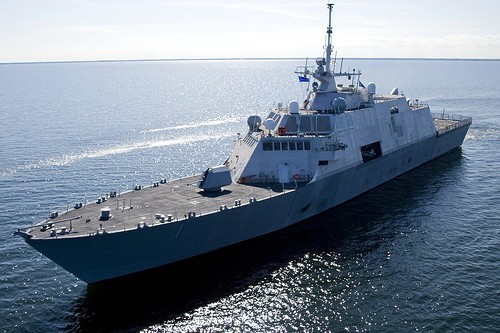
Freedom is the United States Navy's first littoral combat ship to be commissioned as a warship.Littoral Combat Ships are relatively small surface vessels intended for operations in the littoral zone (close to shore). Two ship classes are the first examples of the LCS in the U.S. Navy: the Freedom-class and the Independence-class. LCS designs are slightly smaller than the Navy's guided missile frigates, and have been compared to the corvette of international usage. However, the LCS designs add the capabilities of a small assault transport with a flight deck and hangar large enough to base two SH-60 Seahawk helicopters, the capability to recover and launch small boats from a stern ramp, and enough cargo volume and payload to deliver a small assault force with armored vehicles to a roll-on/roll-off port facility. The standard armament for the LCS are Mk 110 57 mm guns, while modules containing Non-Line-of-Sight Launch Systems or Mark 54 MAKO Lightweight Torpedoes are available. It will also be able to launch autonomous air, surface, and underwater vehicles. Although the LCS designs offer less air defense and surface-to-surface capabilities than comparable destroyers, the LCS concept emphasizes speed, flexible mission module space and a shallow draft.
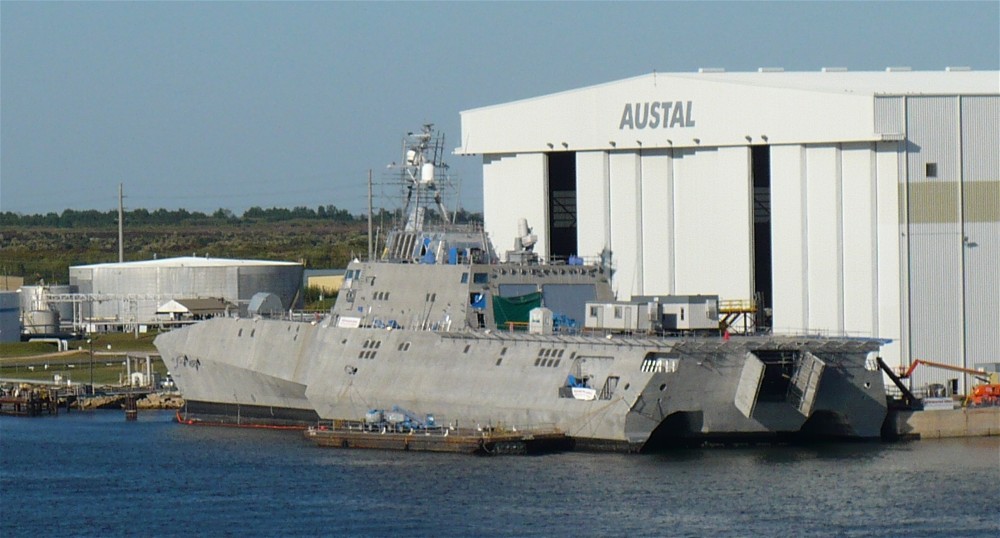
The Trimaran USS Independence (LCS-2) The concept behind the littoral combat ship, as described by Secretary of the Navy Gordon R. England, is to "create a small, fast, maneuverable and relatively inexpensive member of the DD(X) family of ships." The ship is easy to reconfigure for different roles, including anti-submarine warfare, mine countermeasures, anti-surface warfare, intelligence, surveillance and reconnaissance, homeland defense, maritime intercept, special operations, and logistics. Due to its modular design, the LCS will be able to replace slower, more specialized ships such as minesweepers and larger assault ships.
The United State Navy's first littoral combat ship was Sea Fighter, which was launched in 2003. The ship designed with SWATH type hull and designated as Fast Sea Frame or FSF-1. The ship was put into service in 2005 and serves as an experimental test bed ship using mission modules. In 2004, Lockheed Martin, General Dynamics and Raytheon submitted preliminary designs to the Navy. It was decided to produce two vessels each of the Lockheed Martin design (LCS-1 and LCS-3) and of the General Dynamics design (LCS-2 and LCS-4). After these are brought into service, and experience has been gathered on the usability and efficiency of the designs, the future design for the class will be chosen . This may be a decision to use one or the other design in whole, or a combined form made by selecting features from each, or a mixed fleet of both designs. The Navy currently plans to build 55 of these ships.
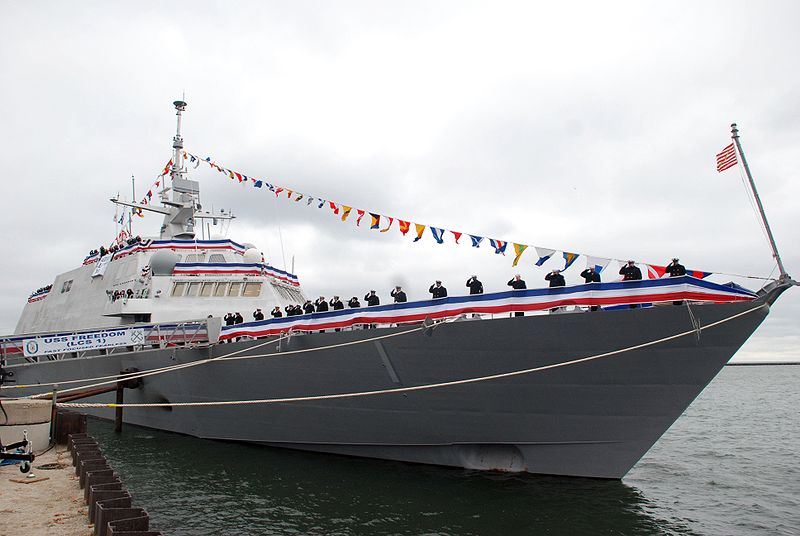
On 9 May 2005, Secretary of the Navy Gordon England announced that the first LCS would be named USS Freedom (LCS-1). Her keel was laid down on 2 June 2005 at Marinette Marine, Marinette, Wisconsin. The contract to build the ship was managed by Lockheed's Maritime Systems and Sensors (MS2) division, directed by Fred Moosally. On 23 September 2006, LCS-1 was christened and launched at the Marinette Marine shipyard. On 19 January 2006, the keel for the General Dynamics trimaran, USS Independence (LCS-2), was laid at the Austal USA shipyards in Mobile, Alabama. LCS-2 was launched 30 April 2008. On 12 April 2007, the Navy canceled the contract with Lockheed Martin for the construction of LCS-3 after negotiations to control cost overruns failed. The second General Dynamics ship (LCS-4) was also canceled on November 1, 2007 after similar cost overruns on their first ship.
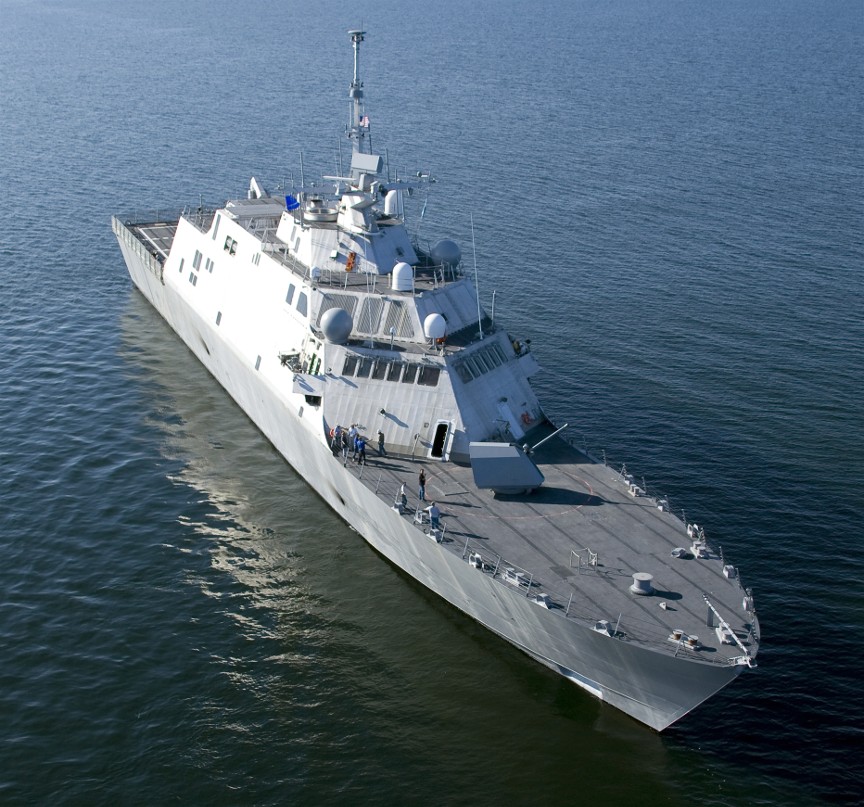
The Navy currently plans a brand new bidding process for the next three ships, with the winner building two ships and the loser only one. On 8 November 2008, the Freedom was commissioned in Veteran's Park, Milwaukee, WI. In the September 26, 2008 U.S. Presidential debate, John McCain denounced the littoral combat ship as an example of botched contracting procedures that drive up the costs of ships unnecessarily. In March 2009, Secretary of the Navy Donald Winters announced that LCS-3 would be named the USS Fort Worth after Fort Worth, Texas and the fourth ship would be named the USS Coronado after Coronado, California.
In March 2009, United States House Armed Services Subcommittee on Seapower and Expeditionary Forces Chairman Gene Taylor (Mississippi) criticized the lack of cost controls on the LCS program, saying that during his tour of the Austal shipyard that "I saw absolutely no effort being made to save the taxpayers a dime." Also in March 2009, the Navy renewed the contract with Lockheed to build its second LCS, the USS Fort Worth (LCS-3). On 6 April 2009, Secretary of Defense Robert Gates announced a Department of Defense budget that would purchase three LCS in FY '10 with a goal of 55 total ships.
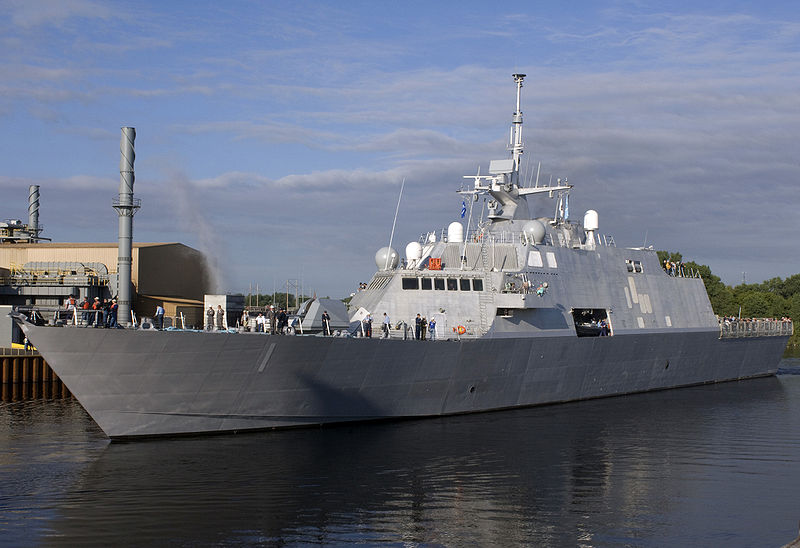
On May 1, 2009, the Navy renewed the contract with Austal/GD to build its second Trimaran LCS, the USS Coronado (LCS-4), with delivery scheduled for May 2012. USS Freedom (LCS-1), the lead ship of the Freedom class of Littoral combat ships (LCS), is the third vessel of the United States Navy to be so named. She is the design competitor produced by the Lockheed Martin consortium, in competition with the General Dynamics-designed USS Independence. She was officially accepted by the Supervisor of Shipbuilding Gulf Coast officially on behalf of the US Navy from the Lockheed Martin/Marinette Marine/Gibbs and Cox team in Marinette, WI on 18 September 2008. She is designed for a variety of missions in shallow waters, capable against submarines and ships, as well as minesweeping and humanitarian relief. The ship is a semi-planing monohull design capable of over 45 knots (83 km/h; 52 mph). Commissioned in Milwaukee, Wisconsin on 8 November 2008, USS Freedom will be home-ported in San Diego, California.

The USS Freedom is the first of two dramatically different LCS designs being produced; the other, USS Independence (LCS-2), is a trimaran under construction by a team led by General Dynamics' Bath Iron Works and Austal USA in Mobile, Alabama. USS Freedom is designed to be a fast, maneuverable and networked surface combatant for missions such as anti-mine warfare, anti-submarine warfare, surface warfare and humanitarian relief. The ship is a semi-planing steel monohull with an aluminum superstructure. It is 377 feet (115 m) in length, displaces 3,000 tonnes and can go faster than 45 knots (52 mph; 83 km/h). The design incorporates a large reconfigurable seaframe to allow rapidly interchangeable mission modules, a flight deck with integrated helicopter launch, recovery and handling system and the capability to launch and recover boats (manned and unmanned) from both the stern and side. The flight deck is 1.5 times the size of that of a standard surface ship, and uses a Trigon traversing system to move helicopters in and out of the hangar. The ship has two ways to launch and recover various mission packages: a stern ramp and a starboard side door near the waterline. It has a roll-on/roll-off ramp. The mission module bay has a 3-axis crane for positioning modules or cargo. The fore deck has a modular weapons zone which can be used for a 57 mm gun turret or missile launcher. A Rolling Airframe Missile launcher is mounted above the hangar for short-range defense against aircraft and cruise missiles, and .50-caliber gun mounts are provided topside. The core crew will be 40 sailors, usually joined by a mission package crew and an aviation detachment for a total crew of about 75. Concept of operations The operational concept includes deployment of a two or three-ship team to operate in the littorals in support of surface strike groups. The operational concept is in direct support of the Navy's Maritime Strategy, "A Cooperative Strategy for 21st Century Seapower." Principal capabilities to include shallow-water anti-submarine warfare, mine countermeasures and defence against attacking small boats. LCS ships are to be networked to share tactical information with other units.
Freedom will be initially based in San Diego with two crews which will alternate four-month tours of sea duty. The construction contract was awarded to Lockheed Martin's LCS team (Lockheed Martin, Gibbs & Cox, Marinette Marine, Bollinger Shipyards) in May 2004. Her keel was laid down on 2 June 2005, by Marinette Marine in Marinette, Wisconsin. The ship was sponsored by Birgit Smith, the widow of United States Army Sergeant 1st Class Paul Ray Smith, who was posthumously awarded the Medal of Honor in Operation Iraqi Freedom. Mrs. Smith's initials are welded on the ship's keel. The couple's Saint Christopher medal and wedding bands are embedded in the ship's mast.
The USS Freedom was christened on 23 September 2006, delivered to the Navy on 18 September 2008, and commissioned in Milwaukee on 8 November. LCS-1 during commissioningCost overruns during Freedom's construction combined with projected future overruns led the government to issue a "Stop-work" in January 2007 and ultimately led to the cancellation of construction of LCS-3 (the second Lockheed Martin ship) on April 13, 2007. On 25 April 2008 the New York Times ran a highly critical article, arguing that both Freedom and competitor Independence demonstrated a failure of the Navy's littoral combat ship program. Prior to delivery, the Navy's Board of Inspection and Survey (INSURV) conducted acceptance trials aboard LCS-1 Aug. 17-21. INSURV found the ship to be "capable, well-built and inspection-ready" and recommended that the Chief of Naval Operations authorize delivery of the ship. Because the trials were conducted in Lake Michigan, some ship systems, including aviation and combat systems, could not be demonstrated. Systems not demonstrated during recent trials will be presented to INSURV in early 2009 trials in Norfolk and in the open ocean.
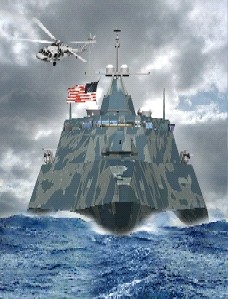
USS Independence (LCS-2), the class prototype for the Independence-class littoral combat ship, will be the sixth ship of the United States Navy to be named for the concept of independence. It is the design competitor produced by the General Dynamics consortium, in competition with the Lockheed Martin-designed USS Freedom, the prototype for the Freedom-class littoral combat ship. It is intended as a small assault transport with a variety of capabilities depending on the mission module installed. The ship is a trimaran design capable of over 40 knots (74 km/h; 46 mph), and will probably be delivered to the US Navy in September 2009. The design for Independence (LCS 2) is based on a proven high-speed trimaran hull built by Austal (Henderson, Australia). The 127-meter surface combatant design calls for a crew of 40 sailors, while the trimaran hull should enable the ship to reach sustainable speeds of nearly 50 knots (60 mph; 90 km/h) and range as far as 10,000 nautical miles (20,000 km).[citation needed] With 11,000 cubic meters of payload volume the ship is designed with twice the objective payload and volume so that it can carry out one mission while a separate mission module is in reserve. The large flight deck, 1,030 square meters (11,100 sf), will support operation of two SH-60 helicopters, unmanned vehicles, or large CH-53 class helicopters. The stable trimaran hull will allow flight operations in high sea conditions.[citation needed] Fixed core capabilities will be carried for self-defense and command and control. However unlike traditional fighting ships with fixed armament such as guns and missiles, innovative and tailored mission modules will be configured for one mission package at a time.
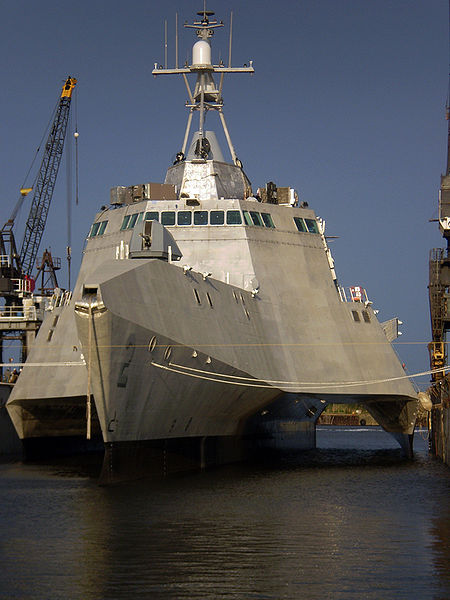
Modules may consist of manned aircraft, unmanned vehicles, off-board sensors, or mission-manning detachments - all in an expandable open systems architecture. The large interior volume and payload is greater than larger destroyers and is sufficient to serve as a high-speed transport and maneuver platform. The mission bay is 11,800 square feet (1,100 m2), and takes up most of the deck below the hangar and flight deck. In addition to cargo or container-sized mission modules, the bay can carry four lanes of multiple Strykers, armored Humvees, and their associated troops. An elevator allows air transport of packages the size of a twenty-foot long shipping container that can be moved into the mission bay while at sea. A side access ramp allows for vehicle roll-on/roll-off loading to a dock. The habitability area is under the bridge with bunks for many personnel. Independence also has an integrated LOS Mast, Sea Giraffe 3D Radar and SeaStar Safire FLIR. Side and forward surfaces are angled for reduced radar profile. In addition, H-60 series helicopters provide airlift, rescue, anti-submarine, radar picket and anti-ship capabilities with torpedoes and missiles. The ship is not designed as a base for the V-22, but the flight deck is large enough to hold them. The contract was awarded to General Dynamics in July 2003. The contract to build her was then awarded to Austal USA of Mobile, Alabama, on 14 October 2005 and her keel was laid down on 19 January 2006. Delivery to the United States Navy was scheduled for December 2008, but will most likely be pushed back to September 2009. The originally planned second General Dynamics ship (LCS-4) was canceled on November 1, 2007. On May 1, 2009, a second LCS-4 was exercised from the FY2009 budget, the USS Coronado (LCS-4), with delivery scheduled for May 2012. The Navy currently plans a new bidding process with the FY2010 budget between Lockheed Martin and General Dynamics for the next three littoral combat ships, with the winner building two ships and the loser only one. Independence was christened October 5, 2008 by Doreen Scott, wife of 10th Master Chief Petty Officer of the Navy Terry D. Scott.




 LCS1
LCS1 